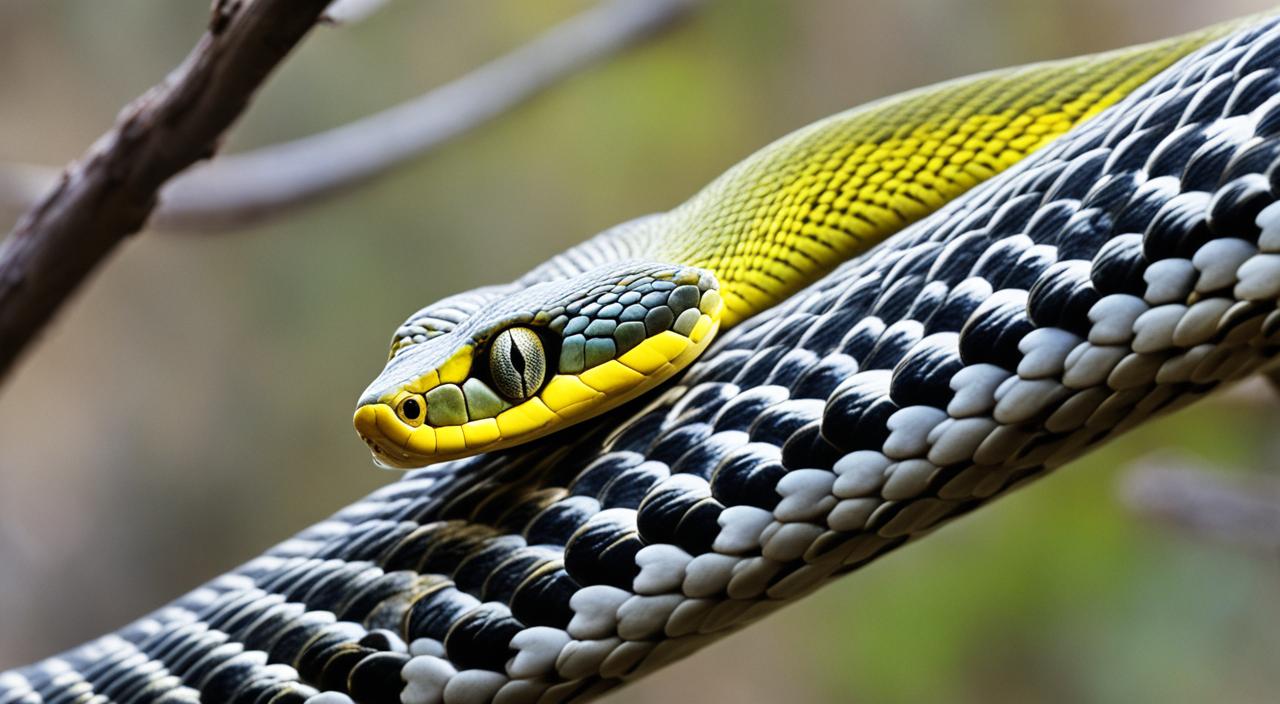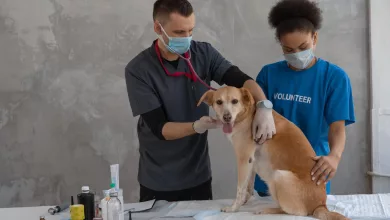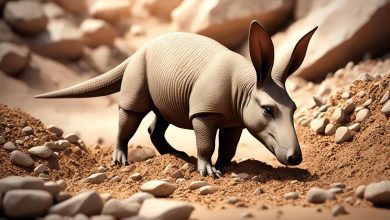My heart raced as I spotted a slender, golden-hued serpent in the Gold Coast Hinterland. It gracefully weaved through dry stems. This was my first encounter with the Yellow-faced Whipsnake, forever changing my view of Australian snakes.
The Demansia psammophis, or Yellow-faced Whipsnake, is a captivating Australian snake. This venomous reptile belongs to the Elapidae family. It’s common across the continent, yet maintains an air of mystery.
The Yellow-faced Whipsnake shares habitats with the Eastern Brown and Red-bellied Black Snake. Yet, it stands out with its unique features. Its sleek body, whip-like tail, and yellow face with dark markings make it special.
Although venomous, this snake isn’t dangerous to humans. It plays a crucial role in Australian ecosystems. You can find it from Gold Coast beaches to the Northern Territory’s Outback.
Let’s explore this remarkable Australian snake’s behaviour, habitat, and ecological importance. It’s a key part of our nation’s rich wildlife tapestry.
Introduction to the Yellow-Faced Whipsnake
The Yellow-faced Whipsnake is a unique Australian serpent. This slender snake is vital to Aussie ecosystems. It’s a key species in snake identification and herpetology studies.
Scientific Classification
The Yellow-faced Whipsnake is part of the Elapidae family. Its scientific name is Demansia psammophis. It belongs to the Demansia genus, which includes 14 whip snake species.
| Kingdom | Phylum | Class | Order | Family | Genus | Species |
|---|---|---|---|---|---|---|
| Animalia | Chordata | Reptilia | Squamata | Elapidae | Demansia | D. psammophis |
Common Names and Etymology
This snake has many names across Australia. It’s often called the Yellow-faced Whip Snake or Eastern Whipsnake. Its name comes from the yellow marks on its face.
Significance in Australian Herpetology
The Yellow-faced Whipsnake is crucial to Australian herpetology. It lives in most parts of Australia, except Tasmania. You can find it in forests, grasslands, and urban areas.
Though venomous, this snake isn’t deadly to humans. It’s shy and prefers to run away when threatened. The species helps control lizard populations, making it ecologically important.
Physical Characteristics and Identification
The Yellow-Faced Whipsnake is a unique Australian reptile. It has distinctive features that make it easy to identify. This slender serpent is native to Australia.
Size and Body Structure
Yellow-Faced Whipsnakes usually grow 0.5 to 1 meter long. Some can reach 1.5 meters. Males are typically larger than females.
They have a slim build and narrow head. These traits define the species.
Colouration and Distinctive Markings
These snakes range from pale grey to olive or blue-gray. Adults often have rust-colored dustings or stripes along their bodies.
Their most striking feature is a narrow, yellow head. They also have pale rings around their eyes.
Differentiating from Similar Species
Yellow-Faced Whipsnakes look like Eastern Brown Snakes. But there are key differences.
- A dark comma-shaped streak from the eye to the mouth corner
- A narrow, yellow-edged dark bar across the snout
- 15 midbody scale rows
- 165-230 ventral scales
- Divided anal and subcaudal scales
These features help tell Yellow-Faced Whipsnakes apart from other Australian reptiles. They’re venomous but not dangerous to humans.
Knowing how to identify them is important for safe interactions. These fascinating creatures are a unique part of Australia’s wildlife.
Habitat and Distribution
The Yellow-faced Whipsnake thrives across Australia’s diverse ecosystems. It adapts to coastal forests and arid scrublands with ease. This snake’s flexibility contributes to its widespread presence throughout the continent.
This snake species inhabits every state except Tasmania. It prefers dry open areas, woodlands, and grasslands. Avoiding swamps and rainforests, it’s often spotted near urban areas.
In Brisbane, the Yellow-faced Whipsnake is a common sight. Its urban presence links to high skink populations, its favourite prey. These snakes shelter in rock crevices and under logs.
- Average length: 65-70cm, with some reaching 80cm
- Habitat: Open forests, woodlands, grasslands
- Distribution: All Australian states except Tasmania
- Urban presence: Common around homes in Brisbane
The Yellow-faced Whipsnake’s adaptability shines through its diverse habitats. Its widespread presence highlights its importance in Australia’s reptile population. This snake’s success story spans from forests to urban settings.
Yellow-Faced Whipsnake Behaviour
The Yellow-faced Whipsnake has unique behaviour patterns. It’s active during the day, unlike many other snakes. This makes it great for studying reptile habits.
Diurnal Activity Patterns
The Yellow-faced Whipsnake loves the daylight. Its eyes are the largest of all Australian snakes. These big eyes help it spot prey and dodge predators.
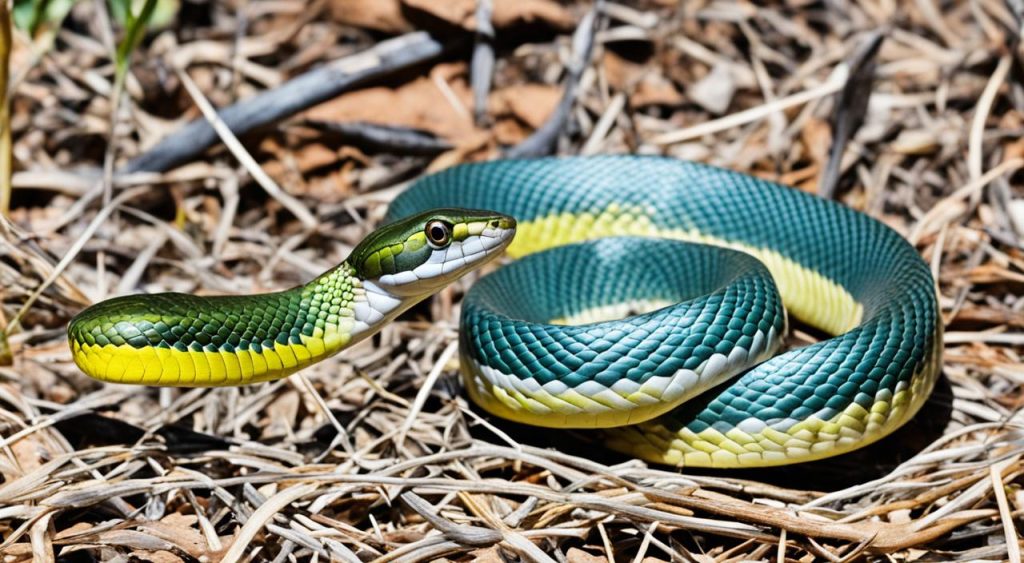
Defensive Mechanisms
This snake is quick to run away when scared. It’s a bit nervous and reacts fast to any disturbance. Its slim body and agility help it move swiftly through its home.
Seasonal Behaviour Changes
The Yellow-faced Whipsnake changes with the seasons. In winter, it enters a state called brumation. During this time, it’s much less active.
Interestingly, these snakes often gather in groups during winter. This shows they have complex social habits. It’s one way they adapt to survive the cold months.
- Diurnal: Active during daylight hours
- Large eyes: Biggest among Australian snakes
- Quick to flee when disturbed
- Brumation: Reduced activity in winter
- Group aggregation during colder months
Diet and Hunting Techniques
The Yellow-faced Whipsnake mainly eats small diurnal lizards. These agile hunters use their keen eyesight to chase and catch swift-moving prey. They also enjoy frogs and lizard eggs.
Young whipsnakes may constrict their catch. Adult snakes use venom to subdue their meals. They strike quickly, injecting venom to immobilise their target.
These snakes hunt both day and night. This ability lets them catch nocturnal geckoes and frogs too.
Research shows interesting facts about the Yellow-faced Whipsnake’s eating habits:
- They prefer larger skinks, showcasing selective predation
- Their hunting success rate surpasses that of some other Australian snakes
- Prey size influences their foraging strategies
| Snake Species | Preferred Prey Size | Hunting Method |
|---|---|---|
| Yellow-faced Whipsnake | Large skinks | Active pursuit |
| Small-eyed Snake | Small and large skinks | Ambush |
| Death Adder | Small skinks | Sit-and-wait |
The Yellow-faced Whipsnake plays a key role in Australian ecosystems. It helps balance lizard populations. This snake is vital in reptile predator-prey relationships.
Reproduction and Life Cycle
Yellow-faced Whipsnakes are oviparous reptiles with unique breeding strategies. They’ve adapted to Australia’s harsh environment to ensure their young survive. These snakes have fascinating reproduction patterns worth exploring.
Mating Habits
Yellow-faced Whipsnakes mate in spring and early summer. Males compete for females through complex courtship displays. These rituals involve gentle biting and body intertwining, as noted by researchers Davis and Carpenter.
Egg-Laying Behaviour
Females lay eggs in early summer, mainly in southern regions. They often lay eggs communally, as observed by Covacevich and Limpus. Nests can hold up to 200 eggs from multiple females.
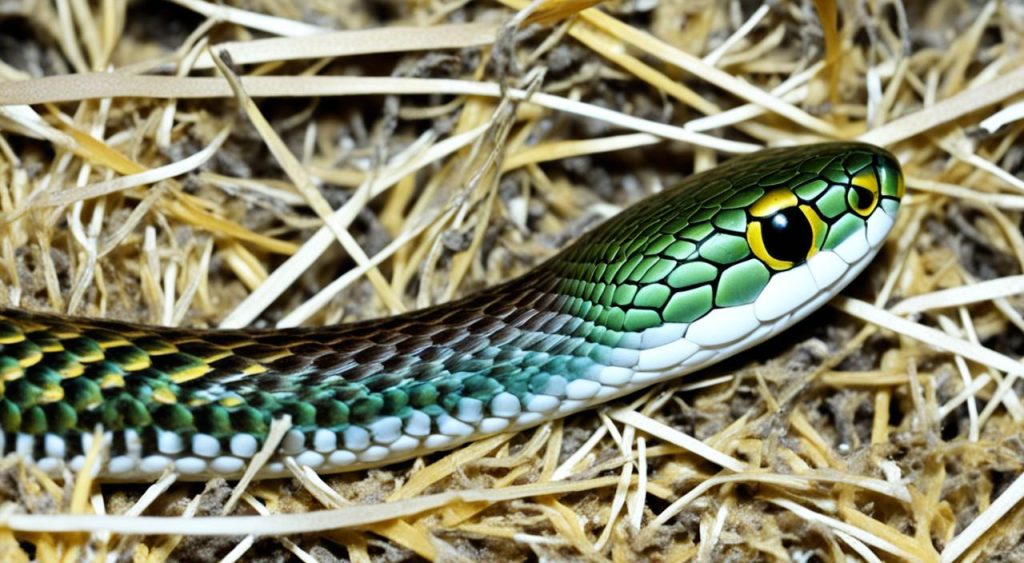
Incubation and Hatching
Egg incubation for Yellow-faced Whipsnakes lasts several weeks. Females choose deep soil or rock crevices for nests. This provides ideal conditions for embryo growth.
Hatchlings emerge between February and March. They measure about 17cm from snout to tail base. Shine’s 1977 study on Australian elapid snakes supports these findings.
Studying Yellow-faced Whipsnake reproduction offers valuable insights. It helps us understand oviparous reptiles and their adaptation to Australia’s diverse ecosystems.
Venom and Toxicity
The Yellow-faced Whipsnake has venom, but it’s milder than other Australian elapid snakes. Its bite isn’t usually life-threatening to humans. However, it can cause discomfort and local symptoms.
The snake’s venom contains elapid toxins that can kill small prey like lizards and frogs. In humans, bites often cause sharp pain and swelling at the site.
Even though the risk to humans is lower, seek medical help after any bite. In rare cases, bites can lead to more severe reactions. These might include mild paralysis or bleeding problems.
| Venom Characteristic | Description |
|---|---|
| Toxicity Level | Mild to moderate |
| Primary Effects | Pain, swelling, local tissue damage |
| Systemic Symptoms | Rare, may include mild paralysis or bleeding |
| Lethality to Humans | Low, not typically life-threatening |
| Effect on Prey | Lethal to small reptiles and amphibians |
The Yellow-faced Whipsnake’s venom is less dangerous than some other Australian snakes. Yet, it’s vital to treat all snake encounters carefully. Understanding its venom helps us appreciate this fascinating reptile’s role in Australian ecosystems.
Ecological Role in Australian Ecosystems
The Yellow-faced Whipsnake is crucial for Australia’s ecosystem balance. It helps control small lizard and frog populations. This snake’s wide distribution makes it key for maintaining biodiversity across various habitats.
Prey-Predator Relationships
The Yellow-faced Whipsnake influences local food webs as both predator and prey. It keeps smaller reptile numbers in check. At the same time, it serves as food for larger predators like birds of prey.
| Snake Species | Average Length (m) | Ecological Role |
|---|---|---|
| Yellow-faced Whipsnake | 0.8 | Mid-level predator |
| Coastal Taipan | 2.6 | Top predator |
| Common Death Adder | 0.4 | Ambush predator |
Impact on Local Biodiversity
The Yellow-faced Whipsnake affects biodiversity across Australia. Its adaptability allows it to influence various ecosystems. Australia has 869 reptile species, with 93% unique to the continent.
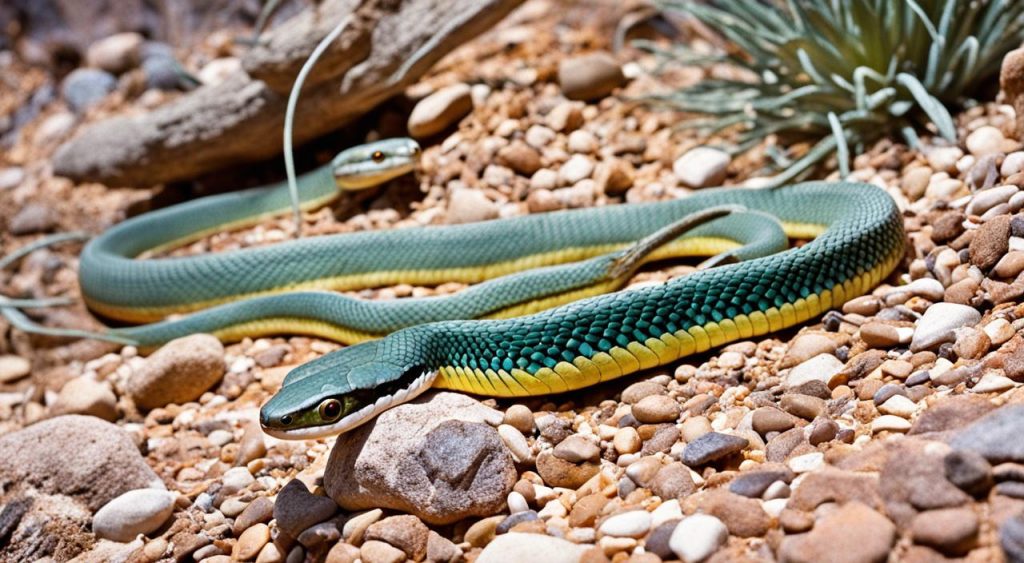
Australia’s reptile diversity is a key part of its unique biodiversity. The Yellow-faced Whipsnake is just one of many important species. From tiny Dwarf Crowned Snakes to massive Saltwater Crocodiles, each fills a special role.
Conservation Status and Threats
The Yellow-Faced Whipsnake faces challenges in its native habitat. Though not endangered, the species grapples with threats that demand attention. Habitat loss is a primary concern, with urban development claiming many known habitats.
Wildlife protection efforts are crucial as the whipsnake battles various predators. Native and introduced species, like California kingsnakes and feral cats, pose risks. Fire suppression has led to habitat degradation, promoting less suitable closed-canopy environments.
Conservation initiatives tackle these challenges head-on. Prescribed burns maintain optimal habitat conditions. Predator control measures reduce threats from introduced species. Educational programs boost public awareness and support for snake conservation.
| Threat | Impact | Conservation Measure |
|---|---|---|
| Habitat Loss | 30 out of 55 known habitats lost | Land acquisition, habitat restoration |
| Predation | Population decline | Predator control programs |
| Fire Suppression | Habitat degradation | Prescribed burns |
| Public Misconception | Human-snake conflicts | Educational programs |
All native reptiles, including the Yellow-Faced Whipsnake, are protected in New South Wales. This legal safeguard aims to lessen the impact of bushland clearance. It also helps combat the effects of urban expansion on snake populations.
Human Interactions and Safety Precautions
Wildlife encounters are common in Australia’s diverse landscapes. Understanding reptile safety is crucial, especially for the Yellow-Faced Whipsnake. This section covers snake bite treatment and safe interactions.
First Aid for Bites
Quick action is vital if bitten by a Yellow-Faced Whipsnake. Keep the victim calm and still. Apply a pressure bandage to slow venom spread.
Seek medical help right away. Proper care is key for recovery.
| Step | Action |
|---|---|
| 1 | Keep victim calm |
| 2 | Immobilise affected limb |
| 3 | Apply pressure bandage |
| 4 | Seek medical help |
Encountering Yellow-Faced Whipsnakes in the Wild
Keep a safe distance from Yellow-Faced Whipsnakes during wildlife encounters. Let the snake retreat on its own. Don’t try to catch or kill it.
These snakes aren’t usually aggressive. But they might defend themselves if they feel threatened.
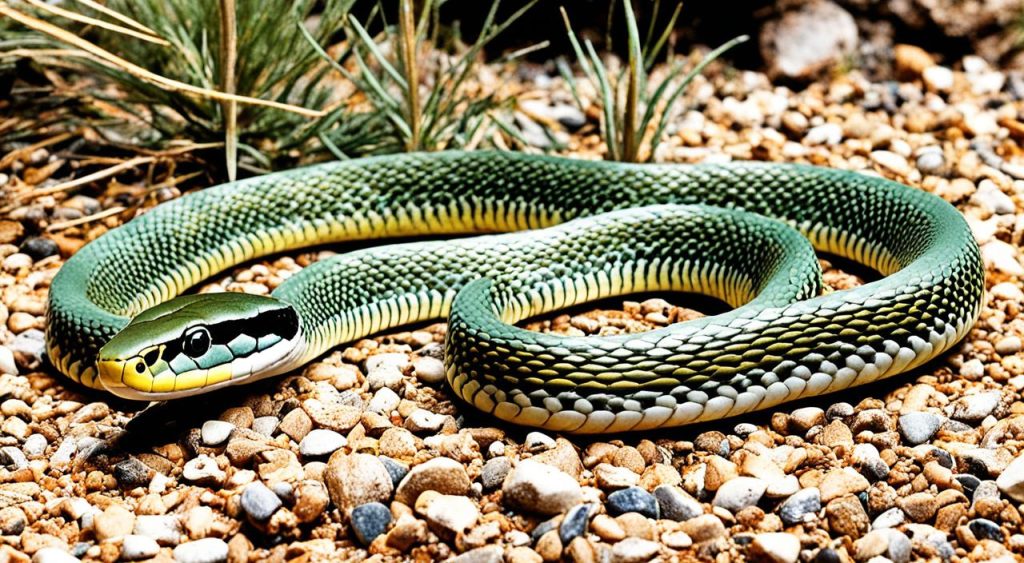
Stay alert in snake habitats. Be careful during outdoor activities in Yellow-Faced Whipsnake areas. Respect their space for safe wildlife encounters in Australia’s beautiful landscapes.
Yellow-Faced Whipsnake in Aboriginal Culture
The Yellow-Faced Whipsnake is important in Aboriginal traditions across Australia. This slender serpent grows up to 75cm long. It has pale olive to brown colouring and mild venom.
Aboriginal communities value snakes in their ecosystems. The Yellow-Faced Whipsnake features in Dreamtime stories. These tales highlight the snake’s traits and behaviours in cultural teachings.
In Aboriginal cultures, snakes often represent creation and rebirth. The Yellow-Faced Whipsnake lives in various habitats across Australia. This wide distribution has led to its inclusion in diverse local stories.
“Our ancestors taught us to respect all creatures, including the Yellow-Faced Whipsnake. It’s part of our land and our stories,” shares an elder from the Northern Rivers region.
Traditional land management considers the Yellow-Faced Whipsnake’s habitat needs. This approach shows the link between Indigenous knowledge and environmental care. Aboriginal communities have found ways to live alongside these creatures.
| Snake Species | Cultural Significance | Conservation Status |
|---|---|---|
| Yellow-Faced Whipsnake | Featured in Dreamtime stories | Common |
| Eastern Brown Snake | Symbol of danger and respect | Least Concern |
| Carpet Python | Associated with wisdom | Not Threatened |
Research and Scientific Studies
Australian herpetology research reveals fascinating insights into the Yellow-faced Whipsnake. Recent studies have uncovered remarkable findings about this species and its relatives. DNA analysis showed a 4% difference between the desert whip snake and other species.
Ecological studies highlight the diverse habitats of whipsnakes across Australia. The desert whip snake blends traits from Western Australia’s reticulated whip snake and the eastern Yellow-faced Whipsnake. It lives in arid regions of Western Australia, South Australia, Queensland, and the Northern Territory.
Over 300 new reptile species have been identified in Australia in the past 20 years. This discovery is part of a broader trend in reptile research.
Research on whipsnake biology provides valuable data on their size and reproduction. The Yellow-faced Whipsnake typically reaches 1 meter in length. Its relative, the Black Whipsnake, can grow up to 1.8 meters.
Breeding studies have uncovered intriguing behaviours in Yellow-faced Whipsnakes. Females return to the same rock crevices yearly to lay their eggs. Some sites have hosted up to a hundred females, highlighting their importance for conservation efforts.
FAQ
What is the scientific name of the Yellow-faced Whipsnake?
The Yellow-faced Whipsnake’s scientific name is Demansia psammophis. It’s part of the Elapidae family of venomous snakes.
What are some distinctive physical characteristics of the Yellow-faced Whipsnake?
The Yellow-faced Whipsnake has a long, slender body and narrow head. Its large eyes and whip-like tail are notable features.
The snake’s yellowish head has a dark marking along the upper lip. Its body colour ranges from pale grey to brown.
Where is the Yellow-faced Whipsnake found in Australia?
The Yellow-faced Whipsnake lives in every Australian state except Tasmania. It thrives in coastal forests, arid scrublands, grasslands, and interior regions.
What is the primary diet of the Yellow-faced Whipsnake?
The Yellow-faced Whipsnake mainly eats small diurnal lizards, frogs, and lizard eggs. It has great eyesight and can catch lizards on the run.
Is the Yellow-faced Whipsnake dangerous to humans?
The Yellow-faced Whipsnake isn’t highly dangerous to adults, but its bite can be very painful. A bite can cause significant local swelling.
If bitten by this snake, seek medical treatment right away.
What is the conservation status of the Yellow-faced Whipsnake?
The Yellow-faced Whipsnake is classified as Least Concern on the IUCN Red List. Its populations are considered stable overall.
However, some local populations may face threats from habitat loss, road deaths, and human persecution.
How should one respond when encountering a Yellow-faced Whipsnake in the wild?
If you see a Yellow-faced Whipsnake, keep a safe distance and let it retreat. If bitten, get medical help immediately.
First aid includes keeping the victim calm and immobilizing the affected limb. Apply a pressure immobilization bandage as well.
What is the significance of the Yellow-faced Whipsnake in Aboriginal culture?
The Yellow-faced Whipsnake is important in Aboriginal culture, like many Australian reptiles. Snakes often feature in Dreamtime stories and traditional knowledge.
Specific beliefs about this snake may vary among different Indigenous groups.
